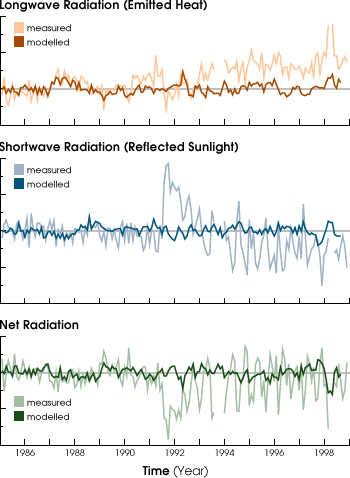

The Trouble with Models |
|||
What is disturbing to Wielicki about these findings isn’t that they point to global warming, but that the climate models used to forecast the effects of global warming failed to pick up on this fluctuation in radiation over the tropics. The models were run in a “hindcast” mode to essentially see if they could forecast changes in climate that had already occurred. Previously measured parameters, such as ocean temperature and solar variability from past years, are plugged into the virtual atmosphere of the climate model. The model is then run forward through the past and into the present to predict changes in other atmospheric parameters like clouds and radiation balance. Ideally, the models should spit out the same values for clouds and radiation balance that are known to exist at present. It’s a way of testing the models and is about as close as one gets to a controlled laboratory type of experiment in climatology. But in this case, the models failed to predict the observed changes. |
|||
 |

“These results render the models suspect. This is exactly the kind of test you’d want these models to pass,” Wielicki explains. In this case, the models’ oversight was particularly worrisome since the magnitude of thermal radiation fluctuation in the tropics was of the same magnitude as the changes in thermal radiation predicted to be caused by greenhouse gases over the next 50 years, which is the primary driver for global warming predictions. Out of five climate models, only one showed a significant correlation with observations in the tropics over the 15-year record, and then only for the emitted thermal fluxes and not for the solar reflected flux. In fact, when it came to simulating the changes in thermal radiation over the past 15 years in the tropics, the difference in readings between models was as large as the actual 4-watt observed change (Wielicki et al. 2002). Wielicki believes that the lack of consensus among the models has to do with their inability to handle the complex physics of clouds and humidity. In general, climate models have trouble with high-flying cirrus clouds and particularly low-lying clouds, such as the stratus clouds that often result in fog along the California coastline. Both types of clouds, however, may play an important role in future climate change. As humans continue to produce more and more greenhouse gases, the Earth’s surface is likely to warm several degrees. One theory is that as the Earth’s surface warms, low-lying clouds worldwide could evaporate during the daytime hours and more high-flying cirrus clouds could form as surface heat causes the air to rise. This would greatly enhance the warming started by the greenhouse gases. But without models that can reliably forecast the behavior of such clouds, scientists can only speculate. As for Wielicki and his team, they want to know what is causing the Hadley-Walker circulation to speed up and precisely how the clouds and humidity above the tropics are changing and affecting radiation. “Most of the cloud data we have now are qualitative and not quantitative. We cannot tell how the clouds are changing from this analysis alone. We need to go back and update cloud data from the 1980s. Then we need to compare the cloud property changes and the radiation changes,” says Wielicki. He explains that in order to understand what has been happening in the tropics, the researchers must look at actual cloud data over a long period of time and compare them to radiation data of the same region. Though there are newer satellites, such as NASA’s TRMM, Terra, and Aqua satellites, that can collect all manner of data on clouds and radiation, most of the data prior to the late 1990s are not reliable by modern standards. For now researchers are working to verify the accuracy of the older data and clean them up, so that they can be used in a continuous time series linked with the newer data. “Generally, the longer the time series, the better chance we have of unscrambling what is going on and seeing if we have a decadal oscillation here. It will also become a good test for how well our models are agreeing,” says Wielicki. In the long run, the information may also help scientists understand more in general about how clouds behave. Scientists may be able to incorporate this new knowledge into their climate models to improve forecasts of future climate change. References:
|
These graphs show measurements of the flow of energy to and from the Earth (light lines), as well as energy flows predicted by computer models (dark lines). The measurements show an increase in heat escaping from the Earth which the models did not predict. Likewise, there was a measured decrease in reflected sunlight that the model results did not show. (Graphs by Robert Simmon, based on data from the CERES Science Team, NASA LaRC) |